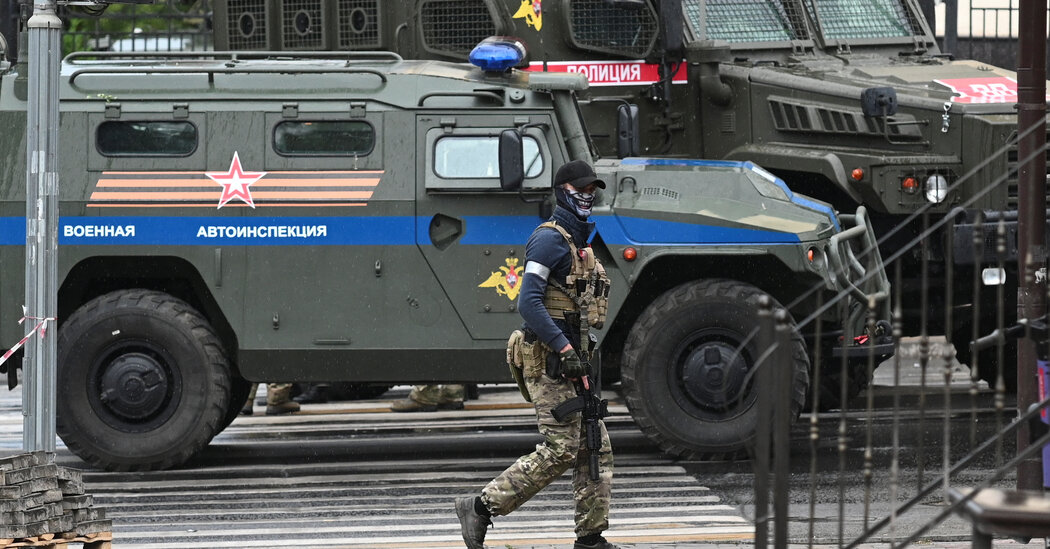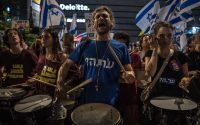The Other Busing Program: Mexico Is Pushing Migrants Back South
The buses rumble into town day and night, dumping migrants in a city many didn’t even know existed.
But instead of landing closer to the U.S. border, they are being hauled roughly 1,000 miles in the opposite direction — deep into southern Mexico in a shadowy program meant to appease the Biden administration and ship migrants far from the United States.
Mexican authorities rarely publicly acknowledge the busing program, making it much less contentious than the efforts by Republican governors to transport migrants to blue states that have become political theater in the United States.
Yet the busing program is exposing the chasm between the Mexican government’s rhetoric promoting a humanitarian approach to migration, and the country’s role as a heavy-handed enforcer of U.S. border objectives, leaving many migrant families stranded to fend for themselves.
“I asked the agents, ‘How can you treat us like dirt?’” said Rosa Guamán, 29, from Ecuador. She was detained with her husband and two children by migration agents in April near the border city of Piedras Negras. Nobody told them they were being taken to Villahermosa, an oil hub in southeastern Mexico, until they were well on their way.
At an overcrowded shelter in Villahermosa, she described the ride as the most dispiriting part of a monthslong journey that included trekking across swaths of jungle, threats of sexual assault and bribing Mexican officials with the hope of getting to New Jersey.
“We’re starting over from zero,” Ms. Guamán said.
Mexico’s National Migration Institute declined to comment. Officials there sometimes frame the detention and transfers of migrants in humanitarian jargon as “rescues” or “dissuasion” aimed at easing conditions in dangerous, overcrowded areas, or they use the technical term “decompression.”
But the busing program is anything but humanitarian, according to immigration lawyers, rights groups and shelter operators in Mexico. The rules for busing migrants south of the border are often cloaked in obscurity — or publicly ignored by authorities at a time when immigration isn’t as polarizing an issue in Mexico’s own election as it is in the United States.
Ernesto Vasconcelo, a Venezuelan-born lawyer who offers legal counseling to migrants in Ciudad Juárez, across the border from El Paso, said there is no public database for lawyers or family members to see where migrants are taken and their current status.
Mexican migration authorities, he said, “refuse to give any information to anyone, they do not allow migrants to have any legal representation, and that is in itself illegal.”
In December, migrant encounters at the U.S.-Mexico border exploded to their highest level on record. Secretary of State Antony Blinken flew to Mexico City for emergency talks aimed at pressing Mexico’s government to do more to curb migration.
Almost immediately after, charter flights and buses started dropping large numbers of people in Villahermosa.
The tactic was effective.
In the first four months of 2024, U.S. border apprehensions plunged in one of the steepest declines in decades, giving the Biden administration some relief as immigration persists as a top voter concern in this year’s election.
A senior White House official who was not authorized to speak publicly said the United States does not dictate what measures Mexico should take to curb migration. The official added that while numbers are down, smugglers are sophisticated and both governments need to closely watch what happens going forward.
Mexican authorities have used busing on occasion for years, but its expansion in recent months spotlights the country’s toughening policies on migration. Eunice Rendon, the coordinator of Migrant Agenda, a coalition of Mexican advocacy groups, said that busing was a “practice meant to wear migrants down, to exhaust them.”
Transferring migrants south, far from their intended destination, imposes not only an emotional and physical toll, Ms. Rendon said, but also a financial burden since they must spend money on transportation, lodging and bribes every time they make the trip north.
Still, busing is part of a strategy that has allowed President Andrés Manuel López Obrador of Mexico to center his country’s U.S. relations around migration, fending off much explicit American criticism in other areas like trade policy, management of energy resources or his treatment of political opponents.
There are doubts as to whether Mexico’s efforts are sustainable.
The country reported about 240,000 migrant apprehensions in January and February but fewer than 7,000 deportations in the same two months, suggesting that most of those apprehended remain in Mexico with the chance to head north again.
And the flow of migrants coming into Mexico from South America persists. Panama said roughly 109,000 people crossed the jungle straddling Central and South America known as the Darién Gap in the first three months of 2024, a 14 percent increase compared to the same period last year.
Villahermosa is one of the top destinations to which migrants are bused. Migrants sleep on the street outside of bus stations and convenience stores. Entire families beg for change at busy intersections.
Nearby, people sit on the sidewalk speaking languages like Hindi and Russian.
Karina del Carmen Vidal, manager of a local migrant shelter, said her facility has room for about 160 people, and has been at or above capacity for months. Hundreds of other families rent out rooms in surrounding areas.
“The migrants arrive here in a complete state of shock,” said Ms. Vidal. In some cases, she said, they had been bused multiple times to Villahermosa.
Migrants in the city described being coerced by Mexican agents into taking the buses, and deprived of information as to where they were going and why.
A Russian man at the shelter recounted being detained in March by migration officials in Mexico City shortly before boarding a flight to Tijuana. Unable to speak Spanish or much English, he struggled to understand what was happening.
“Nobody explained anything to me,” said the man, 34, who asked not to be identified. Using Google Translate, he said he had deserted from the Russian Army with the aim of getting to California, and was afraid relatives in Russia could be targeted if he was identified.
With Mexican officials declining to provide details, it’s unclear how many people have been bused south.
But at least thousands of foreign migrants have been sent to Villahermosa and another southern city, Tapachula, according to migration experts, lawyers and religious leaders.
When they are dropped off, some people opt to stay and apply for asylum in Mexico. Others are given an official “exit notice,” which gives them up to 30 days to leave the country — plenty of time to try going north again.
Others, however, said they were simply left on the street, without being taken to the migrant processing center.
Tonatiuh Guillén, who headed Mexico’s National Migration Institute at the start of Mr. López Obrador’s administration, said that during his tenure, the agency would relocate smaller numbers of migrants, mainly from Central America. He said it was considered easier to process migrants and prepare them for deportation in cities in southern Mexico.
But Mr. Guillen described the current busing policy as a kind of “merry-go-round” in which people are forced to try multiple times to make it across the U.S.-Mexico border, paying bribes time and again to migration officials and police during each attempt.
“It is a perverse scenario for migrants” Mr. Guillén said.
Criticism of the busing program from local authorities in Villahermosa has been somewhat muted, perhaps not surprising since the surrounding Tabasco is a bastion of support for Mr. López Obrador and his home state.
Both the interim mayor of Villahermosa and the former mayor, who is running for re-election, did not respond to requests for comment. Tabasco state’s governor declined to comment. They are all members of the president’s ruling party, Morena.
Still, local media have sought to link the migrant influx to crime fears, casting widespread attention on the cases of a Senegalese man accused of robbing mobile phones, and another migrant said to have boarded a bus to beg for money, then assaulting the driver.
Roberto Valencia Aguirre, a Roman Catholic priest, said he had to abandon a plan to shelter migrants in a church in an affluent part of the city after parishioners voiced objections.
“It was a very unpleasant reaction from some people who said, ‘No, Father, we don’t want migrants here,’” he said.
Hamed Aleaziz contributed reporting from Washington.


